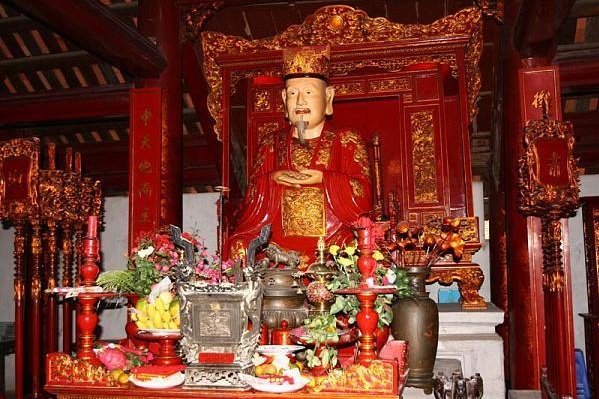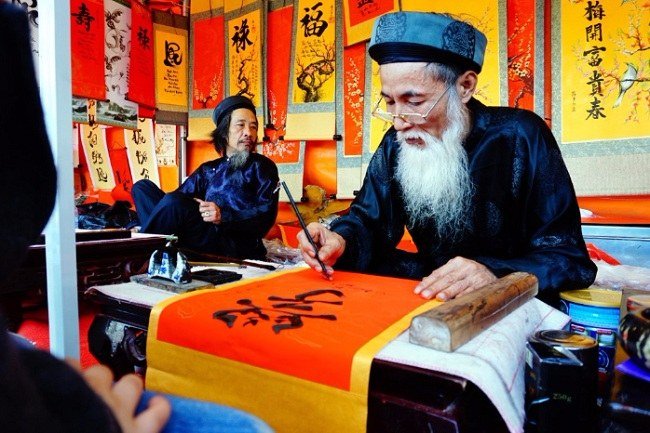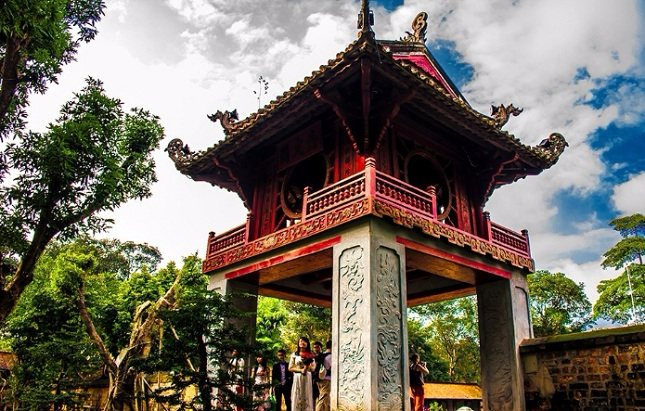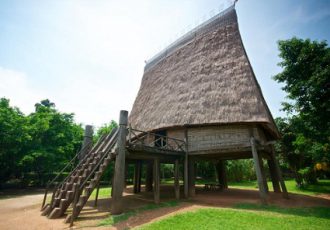Visit of the Temple of Literature
Built in 1070 and dedicated to the worship of Confucius, the temple of literature once hosted princes and children of mandarins and was in fact the first university in Vietnam. Confucian thought and morality were taught there until the end of the 18th century when the university was transferred to Hue. Today the temple welcomes all help and cooperation from cultural and scientific organizations, as well as individuals interested in researching, preserving and developing Vietnam’s national culture. The Temple of Literature University is not only a symbol of Confucianism but also an extremely significant cultural and historical vestige of Vietnam in general and Hanoi in particular.
According to the Complete History of Great Vietnam. : “In the Autumn of the year Canh Tuat, the second year of Vu (1070), in the 8th lunar month, during the reign of Kinh Ly Thanh Tong, the Temple of Literature was built. Statues of Confucius and his top four disciples were carved, along with 72 other statues of Confucian scholars that were painted. Ceremonies were dedicated to them in each of the four seasons. The Crown Princes studied here”.
Architecture
Hanoi’s Temple of Literature – a vast architectural complex of rare beauty – exceeds the size of a temple dedicated to a tall man, to become in the eyes of the Vietnamese the symbol of national education dating back almost a thousand years. already and a cultural center of the capital. The landscape of the temple is often embellished by pretty long tunics of young Vietnamese girls looking for beautiful decorations for their souvenir photos. There are also many young students from fine arts schools in Hanoi who contemplate in silence the ornamental motifs of the temple to reproduce them on their drawings… Each visitor, thanks to this, really feels an atmosphere full of poetry in finding there.
For a foreign visitor, from the first step in this vast complex, you will immediately feel immersed in a cultural landscape very different from his own. The layout of the architectural elements, the typically oriental colors, the meaning of symbols that abound among the ornamental motifs, the Sino-Vietnamese characters… everything is strange and exotic, and therefore, with a minimum amount of knowledge, the visit will be very rewarding.
Overall, the Hanoi Temple of Literature is made up of five courtyards separated by brick walls each of which has three gates. These gates constitute three entrances to the temple. The entrance in the middle-largest leads a visitor up to the house of worship dedicated to Conficus to his prominent followers in the fifth court. But before reaching these main buildings at the bottom, the path of the visit is decorated with pretty monuments and beautiful ornamental trees:

There are the pavilion dedicated to the constellation of literature (Khue Van Cac), the well of Celestial Clarity (Thien Quang Tinh), the Great House of Ceremonies, the statue of Confucius, the stone dragons, the ancient wall, the ink stones. And also the banyan and frangipani and other age-old trees that have witnessed many festivities, ceremonies, literary discussions, study sessions and examinations.
The entrance portico is monumental, followed by two courtyards before reaching the “pavillon of constellation”, a square building with the emblem of the sun on all four sides dedicated to this constellation symbol of literary life.
In the middle of the third court is the “Heavenly Well”, of particular interest with, on the sides, 82 stelae supported by stone turtles. They were erected between 1484 and 1780. There are engraved the names of 1306 winners of the mandarin contests that took place under the Lê dynasty. Then comes the portico of “Good Results” to access the fourth courtyard and the main temple.

Each courtyard of the temple and each architectural element bears a name recalling a particular meaning, often in connection with Confucian teachings or recalling certain symbols from literature or ancient philosophies. For example, the access door to the fourth court housing the altar of Confucius bears the name Dai Thanh meaning “Great Achievement”; the first court after the first door of the temple is baptized with the name “Nhap Mon” meaning “Initiation to studies”. Some great themes of Confucian thought such as balance, harmony, etc. are also translated in a way and another in the forms or in the arrangement of the architectural elements. So, more than a place of worship, it is one of the few Vietnamese monuments that survive through the vicissitudes of time, with indisputable values: time values, aesthetic values, architectural values, documentary values.., etc. It is to note on this last point that the stone steles of doctors of this temple are already recognized by Unesco as a documentary heritage!





